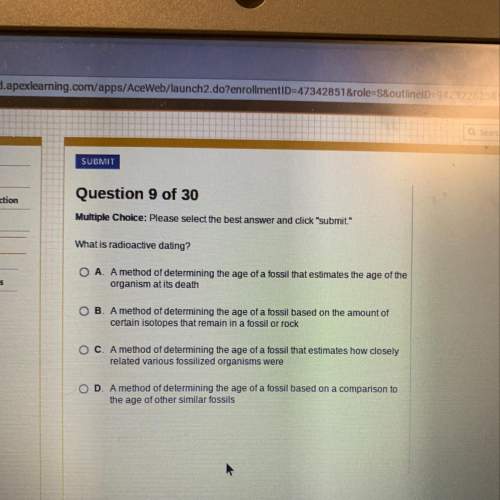
Biology, 01.09.2019 10:20 sawyerharper
Explain why the chromosomes in the second drawing have sister chromatids, but the chromosomes in the third drawing do not. what happened to the sister chromatids?


Answers: 1


Another question on Biology

Biology, 21.06.2019 19:40
In german cockroaches, curved wing (cv) is recessive to normal wing (cv+). bill, who is raising cockroaches in his dorm room, finds that the frequency of the gene for curved wings in his cockroach population is 0.6. in his friend joe’s apartment, the frequency of the gene for curved wings is 0.2. one day joe visits bill in his dorm room, and several cockroaches jump out of joe’s hair and join the population in bill’s room. bill estimates that, now, 10% of the cockroaches in his dorm room are individual roaches that jumped out of joe’s hair. what is the new frequency of curved wings among cockroaches in bill’s room? 0.69 0.4 0.5 0.31 0.20
Answers: 1

Biology, 21.06.2019 23:50
Looking at this image, what relationship can be drawn from it? the lower the degree of latitude, the lower the degree of temperature there is no relationship between latitude and temperature the higher the degree of latitude, the higher the degree of temperature the lower the degree of latitude, the higher the degree of temperature
Answers: 1

Biology, 22.06.2019 06:30
Agroup of students is studying convection currents. they fill two identical balloons with the same amount of helium. one balloon is placed in a freezer and the other in an area with warm air. after 10 minutes, the balloons are released from a height of 1 meter. which of the following do the students most likely observe? question 8 options: the cold balloon expands and rises. the warm balloon shrinks and sinks. the balloons rise at the same rate. both balloons are the same size. the ballons both rise. the cold ballon is larger than the warm balloon. the warm balloon expands and rises. the cold balloon shrinks and sinks.
Answers: 3

Biology, 22.06.2019 12:00
Refer to the family pedigree shown here. in generation i, one parent is affected by the gene mutation and one parent isn't. in generation ii, all three children are affected by the gene mutation. what can you conclude about this gene mutation? a. all children born in future generations will be affected by this disorder. b. this gene mutation is a dominant disorder. c. this gene mutation is a recessive disorder. d. the generation i mother is a carrier of this gene mutation.
Answers: 2
You know the right answer?
Explain why the chromosomes in the second drawing have sister chromatids, but the chromosomes in the...
Questions

Mathematics, 08.01.2020 03:31





Mathematics, 08.01.2020 03:31




Mathematics, 08.01.2020 03:31

History, 08.01.2020 03:31

Health, 08.01.2020 03:31




History, 08.01.2020 03:31

Mathematics, 08.01.2020 03:31

Mathematics, 08.01.2020 03:31





